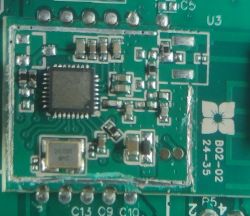Hello everyone,
I am in the process of building a water consumption monitoring based on APATOR water meters. I have received two, brand new APATOR AT-MBUS-NE-02 pulse caps ordered from the distributor . They were made according to a standard configuration, viz:
e.g.: for water meter type JS-1.6-02: Impulse overlay AT-MBUS-NE-02 with:
- impulse output no. 1 - IB
(volume counting like a mechanical counter)
- Pulse output 2 - PR
(volume counting like a classic NK)
- pulse weight 1 dm3/imp
According to the documentation provided by the manufacturer:
http://www.apator.com/uploads/files/Produkty/...cyjna/pl-00061-2015-r-nakladki-at-mbus-ne.pdf
The overlay has an open drain (OD) pulse output /0.17A, 100V/. I have a problem "capturing" pulses from this overlay.
The schematic (thank you user @-Maciej_ Rak ) for connecting this overlay I used the same as in the ORNO-WE-501 1-phase meter already installed with me (works via Arduino Nano), as below :
 .
.
However, with the difference that it is 3.3V instead of 5V (I am using Arduino Pro Mini 3.3 (battery power from 12V 7.2Ah battery + AMS1117 3.3V).
Current wiring diagram:
 .
.
When I take a multimeter, I get a voltage value of 3.3V on the connection terminals of the cap (without connecting it), as soon as I connect the green wire (ground) and the brown or white wire of the cap, I immediately get 0V....
I should add that by "blowing" into the water meter, I can see that the counting mechanism of the "water meter mirror" is rotating, but there is no sign of any generated pulses on the multimeter or on the serial-monitor terminal of the Arduino itself. Could anyone help with the subject? I am yet to visit Apator service (Enbra in Krakow) maybe they can help with solving this puzzle with some other connection scheme, but maybe something else can be solved thanks to you ? Perhaps this is an easy problem to solve and I don't know how to spot it, I'm not an electronics technician, so thank you very much in advance for any hints you can give me.
? Perhaps this is an easy problem to solve and I don't know how to spot it, I'm not an electronics technician, so thank you very much in advance for any hints you can give me.
Thanks and best regards,
Maciek
I am in the process of building a water consumption monitoring based on APATOR water meters. I have received two, brand new APATOR AT-MBUS-NE-02 pulse caps ordered from the distributor . They were made according to a standard configuration, viz:
e.g.: for water meter type JS-1.6-02: Impulse overlay AT-MBUS-NE-02 with:
- impulse output no. 1 - IB
(volume counting like a mechanical counter)
- Pulse output 2 - PR
(volume counting like a classic NK)
- pulse weight 1 dm3/imp
According to the documentation provided by the manufacturer:
http://www.apator.com/uploads/files/Produkty/...cyjna/pl-00061-2015-r-nakladki-at-mbus-ne.pdf
The overlay has an open drain (OD) pulse output /0.17A, 100V/. I have a problem "capturing" pulses from this overlay.
The schematic (thank you user @-Maciej_ Rak ) for connecting this overlay I used the same as in the ORNO-WE-501 1-phase meter already installed with me (works via Arduino Nano), as below :
 .
.
However, with the difference that it is 3.3V instead of 5V (I am using Arduino Pro Mini 3.3 (battery power from 12V 7.2Ah battery + AMS1117 3.3V).
Current wiring diagram:
 .
.
When I take a multimeter, I get a voltage value of 3.3V on the connection terminals of the cap (without connecting it), as soon as I connect the green wire (ground) and the brown or white wire of the cap, I immediately get 0V....
I should add that by "blowing" into the water meter, I can see that the counting mechanism of the "water meter mirror" is rotating, but there is no sign of any generated pulses on the multimeter or on the serial-monitor terminal of the Arduino itself. Could anyone help with the subject? I am yet to visit Apator service (Enbra in Krakow) maybe they can help with solving this puzzle with some other connection scheme, but maybe something else can be solved thanks to you
Thanks and best regards,
Maciek





